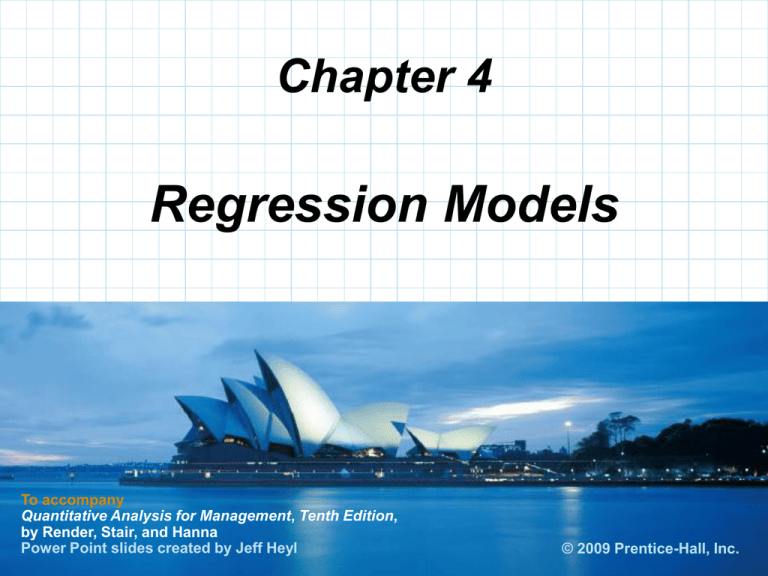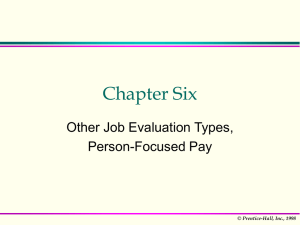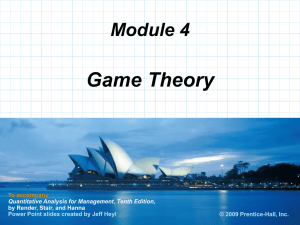Render/Stair/Hanna Chapter 4
advertisement

Chapter 4 Regression Models To accompany Quantitative Analysis for Management, Tenth Edition, by Render, Stair, and Hanna Power Point slides created by Jeff Heyl © 2008 Prentice-Hall, Inc. © 2009 Prentice-Hall, Inc. Learning Objectives After completing this chapter, students will be able to: 1. Identify variables and use them in a regression model 2. Develop simple linear regression equations from sample data and interpret the slope and intercept 3. Compute the coefficient of determination and the coefficient of correlation and interpret their meanings 4. Interpret the F-test in a linear regression model 5. List the assumptions used in regression and use residual plots to identify problems © 2009 Prentice-Hall, Inc. 4–2 Learning Objectives After completing this chapter, students will be able to: 6. Develop a multiple regression model and use it to predict 7. Use dummy variables to model categorical data 8. Determine which variables should be included in a multiple regression model 9. Transform a nonlinear function into a linear one for use in regression 10. Understand and avoid common mistakes made in the use of regression analysis © 2009 Prentice-Hall, Inc. 4–3 Chapter Outline 4.1 4.2 4.3 4.4 Introduction Scatter Diagrams Simple Linear Regression Measuring the Fit of the Regression Model 4.5 Using Computer Software for Regression 4.6 Assumptions of the Regression Model © 2009 Prentice-Hall, Inc. 4–4 Chapter Outline 4.7 4.8 4.9 4.10 4.11 4.12 Testing the Model for Significance Multiple Regression Analysis Binary or Dummy Variables Model Building Nonlinear Regression Cautions and Pitfalls in Regression Analysis © 2009 Prentice-Hall, Inc. 4–5 Introduction Regression analysis is a very valuable tool for a manager Regression can be used to Understand the relationship between variables Predict the value of one variable based on another variable Examples Determining best location for a new store Studying the effectiveness of advertising dollars in increasing sales volume © 2009 Prentice-Hall, Inc. 4–6 Introduction The variable to be predicted is called the dependent variable Sometimes called the response variable The value of this variable depends on the value of the independent variable Sometimes called the explanatory or predictor variable Dependent variable = Independent variable + Independent variable © 2009 Prentice-Hall, Inc. 4–7 Scatter Diagram Graphing is a helpful way to investigate the relationship between variables A scatter diagram or scatter plot is often used The independent variable is normally plotted on the X axis The dependent variable is normally plotted on the Y axis © 2009 Prentice-Hall, Inc. 4–8 Triple A Construction Triple A Construction renovates old homes They have found that the dollar volume of renovation work is dependent on the area payroll TRIPLE A’S SALES ($100,000’s) 6 8 9 5 4.5 9.5 LOCAL PAYROLL ($100,000,000’s) 3 4 6 4 2 5 Table 4.1 © 2009 Prentice-Hall, Inc. 4–9 Triple A Construction 12 – Sales ($100,000) 10 – 8– 6– 4– 2– 0– 0 | 1 | 2 | | | 3 4 5 Payroll ($100 million) | 6 | 7 | 8 Figure 4.1 © 2009 Prentice-Hall, Inc. 4 – 10 Simple Linear Regression Regression models are used to test if there is a relationship between variables (predict sales based on payroll) There is some random error that cannot be predicted Y 0 1X e where Y = dependent variable (response) X = independent variable (predictor or explanatory) 0 = intercept (value of Y when X = 0) 1 = slope of the regression line e = random error © 2009 Prentice-Hall, Inc. 4 – 11 Simple Linear Regression True values for the slope and intercept are not known so they are estimated using sample data Yˆ b0 b1 X where Y^ X b0 b1 = dependent variable (response) = independent variable (predictor or explanatory) = intercept (value of Y when X = 0) = slope of the regression line © 2009 Prentice-Hall, Inc. 4 – 12 Triple A Construction Triple A Construction is trying to predict sales based on area payroll Y = Sales X = Area payroll The line chosen in Figure 4.1 is the one that minimizes the errors Error = (Actual value) – (Predicted value) e Y Yˆ © 2009 Prentice-Hall, Inc. 4 – 13 Least Squares Regression Errors can be positive or negative so the average error could be zero even though individual errors could be large. Sales ($100,000) Least squares regression minimizes the sum of the squared errors. Payroll Line Fit Plot 10 8 6 4 2 0 0 2 4 6 Payroll ($100.000,000's) 8 © 2009 Prentice-Hall, Inc. 4 – 14 Triple A Construction For the simple linear regression model, the values of the intercept and slope can be calculated using the formulas below Yˆ b0 b1 X X X average (mean) of X values n Y Y average (mean) of Y values n ( X X )(Y Y ) b1 2 ( X X ) b0 Y b1 X © 2009 Prentice-Hall, Inc. 4 – 15 Triple A Construction Regression calculations Y X (X – X)2 (X – X)(Y – Y) 6 8 9 5 4.5 3 4 6 4 2 (3 – 4)2 = 1 (4 – 4)2 = 0 (6 – 4)2 = 4 (4 – 4)2 = 0 (2 – 4)2 = 4 (3 – 4)(6 – 7) = 1 (4 – 4)(8 – 7) = 0 (6 – 4)(9 – 7) = 4 (4 – 4)(5 – 7) = 0 (2 – 4)(4.5 – 7) = 5 9.5 5 (5 – 4)2 = 1 (5 – 4)(9.5 – 7) = 2.5 Σ(X – X)2 = 10 Σ(X – X)(Y – Y) = 12.5 ΣY = 42 Y = 42/6 = 7 ΣX = 24 X = 24/6 = 4 Table 4.2 © 2009 Prentice-Hall, Inc. 4 – 16 Triple A Construction Regression calculations X 24 X 4 6 6 Y 42 Y 7 6 b1 6 ( X X )(Y Y ) 12.5 1.25 10 (X X ) 2 b0 Y b1 X 7 (1.25)( 4) 2 Therefore Yˆ 2 1.25 X © 2009 Prentice-Hall, Inc. 4 – 17 Triple A Construction Regression calculations X 24 X 4 sales = 2 + 1.25(payroll) Y 42 Y 7 If the payroll next year is $600 million 6 6 b1 6 6 ˆ 1.5 .25(6) 9.5 or $ 950,000 ( X X )(Y YY ) 2 12 1.25 10 (X X ) 2 b0 Y b1 X 7 (1.25)( 4) 2 Therefore Yˆ 2 1.25 X © 2009 Prentice-Hall, Inc. 4 – 18 Measuring the Fit of the Regression Model Regression models can be developed for any variables X and Y How do we know the model is actually helpful in predicting Y based on X? We could just take the average error, but the positive and negative errors would cancel each other out Three measures of variability are SST – Total variability about the mean SSE – Variability about the regression line SSR – Total variability that is explained by the model © 2009 Prentice-Hall, Inc. 4 – 19 Measuring the Fit of the Regression Model Sum of the squares total SST (Y Y )2 Sum of the squared error SSE e 2 (Y Yˆ )2 Sum of squares due to regression SSR (Yˆ Y )2 An important relationship SST SSR SSE © 2009 Prentice-Hall, Inc. 4 – 20 Measuring the Fit of the Regression Model X (Y – Y)2 Y^ ^ 2 (Y – Y) (Y^ – Y)2 6 3 (6 – 7)2 = 1 2 + 1.25(3) = 5.75 0.0625 1.563 8 4 (8 – 7)2 = 1 2 + 1.25(4) = 7.00 1 0 9 6 (9 – 7)2 = 4 2 + 1.25(6) = 9.50 0.25 6.25 5 4 (5 – 7)2 = 4 2 + 1.25(4) = 7.00 4 0 4.5 2 (4.5 – 7)2 = 6.25 2 + 1.25(2) = 4.50 0 6.25 9.5 5 (9.5 – 7)2 = 6.25 2 + 1.25(5) = 8.25 1.5625 1.563 Y ∑(Y – Y)2 = 22.5 Y=7 SST = 22.5 ^2 ∑(Y – Y) = 6.875 ∑(Y^ – Y)2 = 15.625 SSE = 6.875 SSR = 15.625 Table 4.3 © 2009 Prentice-Hall, Inc. 4 – 21 Measuring the Fit of the Regression Model Sum of the squares total For Triple A Construction 2 SST (Y Y ) SST = 22.5 Sum of the squared error SSE = 6.875 SSRˆ=215.625 2 SSE e (Y Y ) Sum of squares due to regression SSR (Yˆ Y )2 An important relationship SST SSR SSE SSR – explained variability SSE – unexplained variability © 2009 Prentice-Hall, Inc. 4 – 22 Measuring the Fit of the Regression Model 12 – ^ Y = 2 + 1.25X 10 – Sales ($100,000) ^ Y–Y 8– ^ Y–Y Y–Y Y 6– 4– 2– 0– 0 | 1 | 2 | | | 3 4 5 Payroll ($100 million) | 6 | 7 | 8 Figure 4.2 © 2009 Prentice-Hall, Inc. 4 – 23 Coefficient of Determination The proportion of the variability in Y explained by regression equation is called the coefficient of determination The coefficient of determination is r2 SSR SSE r 1 SST SST 2 For Triple A Construction 15.625 r 0.6944 22.5 2 About 69% of the variability in Y is explained by the equation based on payroll (X) © 2009 Prentice-Hall, Inc. 4 – 24 Correlation Coefficient The correlation coefficient is an expression of the strength of the linear relationship It will always be between +1 and –1 The correlation coefficient is r r r2 For Triple A Construction r 0.6944 0.8333 © 2009 Prentice-Hall, Inc. 4 – 25 Correlation Coefficient Y Y * * * * * * ** * * * * * * * * (a) Perfect Positive X Correlation: r = +1 Y X Y * * * * * * * * * * *** * Figure 4.3 (b) Positive Correlation: 0<r<1 (c) No Correlation: r=0 * * X * * (d) Perfect Negative X Correlation: r = –1 © 2009 Prentice-Hall, Inc. 4 – 26 Using Computer Software for Regression Program 4.1A © 2009 Prentice-Hall, Inc. 4 – 27 Using Computer Software for Regression Program 4.1B © 2009 Prentice-Hall, Inc. 4 – 28 Using Computer Software for Regression Program 4.1C © 2009 Prentice-Hall, Inc. 4 – 29 Using Computer Software for Regression Program 4.1D © 2009 Prentice-Hall, Inc. 4 – 30 Using Computer Software for Regression Correlation coefficient is called Multiple R in Excel Program 4.1D © 2009 Prentice-Hall, Inc. 4 – 31 Assumptions of the Regression Model If we make certain assumptions about the errors in a regression model, we can perform statistical tests to determine if the model is useful 1. 2. 3. 4. Errors are independent Errors are normally distributed Errors have a mean of zero Errors have a constant variance A plot of the residuals (errors) will often highlight any glaring violations of the assumption © 2009 Prentice-Hall, Inc. 4 – 32 Residual Plots Error A random plot of residuals X Figure 4.4A © 2009 Prentice-Hall, Inc. 4 – 33 Residual Plots Nonconstant error variance Errors increase as X increases, violating the Error constant variance assumption X Figure 4.4B © 2009 Prentice-Hall, Inc. 4 – 34 Residual Plots Nonlinear relationship Errors consistently increasing and then consistently Error decreasing indicate that the model is not linear X Figure 4.4C © 2009 Prentice-Hall, Inc. 4 – 35 Estimating the Variance Errors are assumed to have a constant variance ( 2), but we usually don’t know this It can be estimated using the mean squared error (MSE), s2 SSE s MSE n k 1 2 where n = number of observations in the sample k = number of independent variables © 2009 Prentice-Hall, Inc. 4 – 36 Estimating the Variance For Triple A Construction SSE 6.8750 6.8750 s MSE 1.7188 n k 1 6 1 1 4 2 We can estimate the standard deviation, s This is also called the standard error of the estimate or the standard deviation of the regression s MSE 1.7188 1.31 © 2009 Prentice-Hall, Inc. 4 – 37 Testing the Model for Significance When the sample size is too small, you can get good values for MSE and r2 even if there is no relationship between the variables Testing the model for significance helps determine if the values are meaningful We do this by performing a statistical hypothesis test © 2009 Prentice-Hall, Inc. 4 – 38 Testing the Model for Significance We start with the general linear model Y 0 1X e If 1 = 0, the null hypothesis is that there is no relationship between X and Y The alternate hypothesis is that there is a linear relationship (1 ≠ 0) If the null hypothesis can be rejected, we have proven there is a relationship We use the F statistic for this test © 2009 Prentice-Hall, Inc. 4 – 39 Testing the Model for Significance The F statistic is based on the MSE and MSR SSR MSR k where k = number of independent variables in the model The F statistic is MSR F MSE This describes an F distribution with degrees of freedom for the numerator = df1 = k degrees of freedom for the denominator = df2 = n – k – 1 © 2009 Prentice-Hall, Inc. 4 – 40 Testing the Model for Significance If there is very little error, the MSE would be small and the F-statistic would be large indicating the model is useful If the F-statistic is large, the significance level (p-value) will be low, indicating it is unlikely this would have occurred by chance So when the F-value is large, we can reject the null hypothesis and accept that there is a linear relationship between X and Y and the values of the MSE and r2 are meaningful © 2009 Prentice-Hall, Inc. 4 – 41 Steps in a Hypothesis Test 1. Specify null and alternative hypotheses H0 : 1 0 H1 : 1 0 2. Select the level of significance (). Common values are 0.01 and 0.05 3. Calculate the value of the test statistic using the formula MSR F MSE © 2009 Prentice-Hall, Inc. 4 – 42 Steps in a Hypothesis Test 4. Make a decision using one of the following methods a) Reject the null hypothesis if the test statistic is greater than the F-value from the table in Appendix D. Otherwise, do not reject the null hypothesis: Reject if Fcalculated F ,df1 ,df2 df1 k df2 n k 1 b) Reject the null hypothesis if the observed significance level, or p-value, is less than the level of significance (). Otherwise, do not reject the null hypothesis: p - value P( F calculated test statistic ) Reject if p - value © 2009 Prentice-Hall, Inc. 4 – 43 Triple A Construction Step 1. H 0: 1 = 0 H1: 1 ≠ 0 (no linear relationship between X and Y) (linear relationship exists between X and Y) Step 2. Select = 0.05 Step 3. Calculate the value of the test statistic SSR 15.6250 15.6250 k 1 MSR 15.6250 F 9.09 MSE 1.7188 MSR © 2009 Prentice-Hall, Inc. 4 – 44 Triple A Construction Step 4. Reject the null hypothesis if the test statistic is greater than the F-value in Appendix D df1 = k = 1 df2 = n – k – 1 = 6 – 1 – 1 = 4 The value of F associated with a 5% level of significance and with degrees of freedom 1 and 4 is found in Appendix D F0.05,1,4 = 7.71 Fcalculated = 9.09 Reject H0 because 9.09 > 7.71 © 2009 Prentice-Hall, Inc. 4 – 45 Triple A Construction We can conclude there is a statistically significant relationship between X and Y The r2 value of 0.69 means about 69% of the variability in sales (Y) is explained by local payroll (X) 0.05 F = 7.71 9.09 Figure 4.5 © 2009 Prentice-Hall, Inc. 4 – 46 r2 coefficient of determination The F-test determines whether or not there is a relationship between the variables. r2 (coefficient of determination) is the best measure of the strength of the prediction relationship between the X and Y variables. • Values closer to 1 indicate a strong prediction relationship. • Good regression models have a low significance level for the F-test and high r2 value. © 2009 Prentice-Hall, Inc. 4 – 47 Coefficient Hypotheses Statistical tests of significance can be performed on the coefficients. The null hypothesis is that the coefficient of X (i.e., the slope of the line) is 0 i.e., X is not useful in predicting Y P values are the observed significance level and can be used to test the null hypothesis. Values less than 5% negate the null hypothesis and indicate that X is useful in predicting Y For a simple linear regression, the test of the regression coefficients gives the same information as the F-test. © 2009 Prentice-Hall, Inc. 4 – 48 Analysis of Variance (ANOVA) Table When software is used to develop a regression model, an ANOVA table is typically created that shows the observed significance level (p-value) for the calculated F value This can be compared to the level of significance () to make a decision DF SS MS Regression k SSR MSR = SSR/k Residual n-k-1 SSE MSE = SSE/(n - k - 1) Total n-1 SST F SIGNIFICANCE MSR/MSE P(F > MSR/MSE) Table 4.4 © 2009 Prentice-Hall, Inc. 4 – 49 ANOVA for Triple A Construction Program 4.1D (partial) P(F > 9.0909) = 0.0394 Because this probability is less than 0.05, we reject the null hypothesis of no linear relationship and conclude there is a linear relationship between X and Y © 2009 Prentice-Hall, Inc. 4 – 50 Multiple Regression Analysis Multiple regression models are extensions to the simple linear model and allow the creation of models with several independent variables Y = 0 + 1X1 + 2X2 + … + kXk + e where Y = dependent variable (response variable) Xi = ith independent variable (predictor or explanatory variable) 0 = intercept (value of Y when all Xi = 0) I = coefficient of the ith independent variable k = number of independent variables e = random error © 2009 Prentice-Hall, Inc. 4 – 51 Multiple Regression Analysis To estimate these values, a sample is taken the following equation developed Yˆ b0 b1 X 1 b2 X 2 ... bk X k where Yˆ = predicted value of Y b0 = sample intercept (and is an estimate of 0) bi = sample coefficient of the ith variable (and is an estimate of i) © 2009 Prentice-Hall, Inc. 4 – 52 Jenny Wilson Realty Jenny Wilson wants to develop a model to determine the suggested listing price for houses based on the size and age of the house Yˆ b0 b1 X 1 b2 X 2 ... bk X k where Yˆ = predicted value of dependent variable (selling price) b0 = Y intercept X1 and X2 = value of the two independent variables (square footage and age) respectively b1 and b2 = slopes for X1 and X2 respectively She selects a sample of houses that have sold recently and records the data shown in Table 4.5 © 2009 Prentice-Hall, Inc. 4 – 53 Jenny Wilson Realty SELLING PRICE ($) Table 4.5 SQUARE FOOTAGE AGE 95,000 1,926 30 Good 119,000 2,069 40 Excellent 124,800 1,720 30 Excellent 135,000 1,396 15 Good 142,000 1,706 32 Mint 145,000 1,847 38 Mint 159,000 1,950 27 Mint 165,000 2,323 30 Excellent 182,000 2,285 26 Mint 183,000 3,752 35 Good 200,000 2,300 18 Good 211,000 2,525 17 Good 215,000 3,800 40 Excellent 219,000 1,740 12 Mint CONDITION © 2009 Prentice-Hall, Inc. 4 – 54 Jenny Wilson Realty Program 4.2 Yˆ 146631 44 X 1 2899 X 2 © 2009 Prentice-Hall, Inc. 4 – 55 Evaluating Multiple Regression Models Evaluation is similar to simple linear regression models The p-value for the F-test and r2 are interpreted the same The hypothesis is different because there is more than one independent variable The F-test is investigating whether all the coefficients are equal to 0 © 2009 Prentice-Hall, Inc. 4 – 56 Evaluating Multiple Regression Models To determine which independent variables are significant, tests are performed for each variable H0 : 1 0 H1 : 1 0 The test statistic is calculated and if the p-value is lower than the level of significance (), the null hypothesis is rejected © 2009 Prentice-Hall, Inc. 4 – 57 Jenny Wilson Realty The model is statistically significant The p-value for the F-test is 0.002 r2 = 0.6719 so the model explains about 67% of the variation in selling price (Y) But the F-test is for the entire model and we can’t tell if one or both of the independent variables are significant By calculating the p-value of each variable, we can assess the significance of the individual variables Since the p-value for X1 (square footage) and X2 (age) are both less than the significance level of 0.05, both null hypotheses can be rejected © 2009 Prentice-Hall, Inc. 4 – 58 Binary or Dummy Variables Binary (or dummy or indicator) variables are special variables created for qualitative data A dummy variable is assigned a value of 1 if a particular condition is met and a value of 0 otherwise The number of dummy variables must equal one less than the number of categories of the qualitative variable © 2009 Prentice-Hall, Inc. 4 – 59 Jenny Wilson Realty Jenny believes a better model can be developed if she includes information about the condition of the property X3 = 1 if house is in excellent condition = 0 otherwise X4 = 1 if house is in mint condition = 0 otherwise Two dummy variables are used to describe the three categories of condition No variable is needed for “good” condition since if both X3 and X4 = 0, the house must be in good condition © 2009 Prentice-Hall, Inc. 4 – 60 Jenny Wilson Realty Program 4.3 © 2009 Prentice-Hall, Inc. 4 – 61 Jenny Wilson Realty Yˆ 121,658 56.43 X 1 3,962 X 2 33,162 X 3 47,369 X 4 Model explains about 90% of the variation in selling price F-value indicates significance Low p-values indicate each variable is significant Program 4.3 © 2009 Prentice-Hall, Inc. 4 – 62 Model Building The best model is a statistically significant model with a high r2 and few variables As more variables are added to the model, the r2-value usually increases For this reason, the adjusted r2 value is often used to determine the usefulness of an additional variable The adjusted r2 takes into account the number of independent variables in the model When variables are added to the model, the value of r2 can never decrease; however, the adjusted r2 may decrease. © 2009 Prentice-Hall, Inc. 4 – 63 Model Building The formula for r2 SSR SSE r 1 SST SST 2 The formula for adjusted r2 SSE /( n k 1) Adjusted r 1 SST /( n 1) 2 As the number of variables increases, the adjusted r2 gets smaller unless the increase due to the new variable is large enough to offset the change in k © 2009 Prentice-Hall, Inc. 4 – 64 Model Building It is tempting to keep adding variables to a model to try to increase r2 The adjusted r2 will decrease if additional independent variables are not beneficial. As the number of variables (k) increases, n-k-1 decreases. This causes SSE/(n-k-1) to increase which in turn decreases the adjusted r2 unless the extra variable causes a significant decrease in SSE The reduction in error (and SSE) must be sufficient to offset the change in k © 2009 Prentice-Hall, Inc. 4 – 65 Model Building In general, if a new variable increases the adjusted r2, it should probably be included in the model In some cases, variables contain duplicate information When two independent variables are correlated, they are said to be collinear (e.g., monthly salary expenses and annual salary expenses) When more than two independent variables are correlated, multicollinearity exists When multicollinearity is present, hypothesis tests for the individual coefficients are not valid but the model may still be useful © 2009 Prentice-Hall, Inc. 4 – 66 Nonlinear Regression In some situations, variables are not linear Transformations may be used to turn a nonlinear model into a linear model * ** * *** * * Linear relationship * * ** * ** * * * * Nonlinear relationship © 2009 Prentice-Hall, Inc. 4 – 67 Colonel Motors The engineers want to use regression analysis to improve fuel efficiency They have been asked to study the impact of weight on miles per gallon (MPG) MPG 12 13 15 18 19 19 WEIGHT (1,000 LBS.) 4.58 4.66 4.02 2.53 3.09 3.11 MPG 20 23 24 33 36 42 WEIGHT (1,000 LBS.) 3.18 2.68 2.65 1.70 1.95 1.92 Table 4.6 © 2009 Prentice-Hall, Inc. 4 – 68 Colonel Motors 45 – 40 – 35 – 30 – MPG Linear model Yˆ b0 b1 X 1 25 – 20 – 15 – 10 – 5– 0– Figure 4.6A | | | | | 1.00 2.00 3.00 4.00 5.00 Weight (1,000 lb.) © 2009 Prentice-Hall, Inc. 4 – 69 Colonel Motors Program 4.4 A useful model with a small F-test for significance and a good r2 value © 2009 Prentice-Hall, Inc. 4 – 70 Colonel Motors 45 – 40 – 35 – 30 – MPG Nonlinear model MPG b0 b1( weight ) b2 ( weight )2 25 – 20 – 15 – 10 – 5– 0– Figure 4.6B | | | | | 1.00 2.00 3.00 4.00 5.00 Weight (1,000 lb.) © 2009 Prentice-Hall, Inc. 4 – 71 Colonel Motors The nonlinear model is a quadratic model The easiest way to work with this model is to develop a new variable X 2 ( weight )2 This gives us a model that can be solved with linear regression software Yˆ b0 b1 X 1 b2 X 2 © 2009 Prentice-Hall, Inc. 4 – 72 Colonel Motors Yˆ 79.8 30.2 X 1 3.4 X 2 Program 4.5 A better model with a smaller F-test for significance and a larger adjusted r2 value © 2009 Prentice-Hall, Inc. 4 – 73 Cautions and Pitfalls If the assumptions are not met, the statistical test may not be valid Correlation does not necessarily mean causation Your annual salary and the price of cars may be correlated but one does not cause the other Multicollinearity makes interpreting coefficients problematic, but the model may still be good Using a regression model beyond the range of X is questionable, the relationship may not hold outside the sample data © 2009 Prentice-Hall, Inc. 4 – 74 Cautions and Pitfalls t-tests for the intercept (b0) may be ignored as this point is often outside the range of the model A linear relationship may not be the best relationship, even if the F-test returns an acceptable value A nonlinear relationship can exist even if a linear relationship does not Just because a relationship is statistically significant doesn't mean it has any practical value © 2009 Prentice-Hall, Inc. 4 – 75









